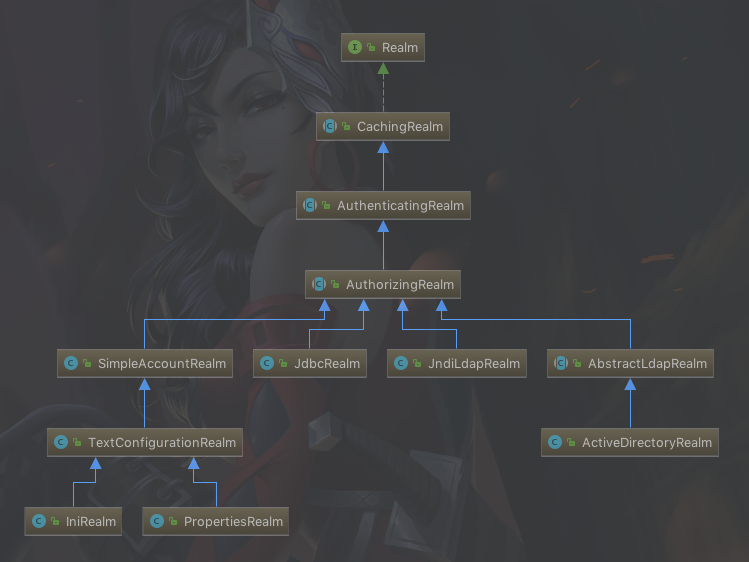认证,即在应用中谁能证明他就是他本人。一般提供如他们的身份ID一些标识信息来表明他就是他本人,如提供身份证,用户名/密码来证明。
在shiro中,用户需要提供 principals(身份)和 credentials(证明)给shiro,从而应用能验证用户身份:
- principals:身份,即主体的标识属性,可以是任何东西,如用户名、邮箱等,唯一即可。一个主体可以有多个principals,但只有一个Primary principals,一般是用户名/手机号。
- credentials:证明/凭证,即只有主体知道的安全值,如密码/数字证书等。
最常见的principals和credentials组合就是用户名/密码了。接下来先进行一个基本的身份认证。
认证流程
首先引入shiro-core包依赖:
在resources类路径下创建文件shiro.ini:
此处使用ini配置文件,通过[users]指定了两个主体:zhang/123、wang/123。
测试用例:
- 首先通过
new IniSecurityManagerFactory并指定一个ini配置文件来创建一个SecurityManager工厂; - 接着获取
SecurityManager并绑定到SecurityUtils,这是一个全局设置,设置一次即可; - 通过
SecurityUtils得到Subject,其会自动绑定到当前线程;如果在web环境在请求结束时需要解除绑定;然后获取身份验证的Token,如用户名/密码; - 调用
subject.login方法进行登录,其会自动委托给SecurityManager.login方法进行登录; - 如果身份验证失败请捕获
AuthenticationException或其子类,常见的如:DisabledAccountException(禁用的帐号)、LockedAccountException(锁定的帐号)、UnknownAccountException(错误的帐号)、ExcessiveAttemptsException(登录失败次数过多)、IncorrectCredentialsException(错误的凭证)、ExpiredCredentialsException(过期的凭证)等,具体请查看其继承关系;对于页面的错误消息展示,最好使用如“用户名/密码错误”而不是“用户名错误”/“密码错误”,防止一些恶意用户非法扫描帐号库; - 最后可以调用
subject.logout退出,其会自动委托给SecurityManager.logout方法退出。
认证流程:

流程如下:
- 首先调用
Subject.login(token)进行登录,其会自动委托给SecurityManager,调用之前必须通过SecurityUtils.setSecurityManager()设置; SecurityManager负责真正的身份验证逻辑;它会委托给Authenticator进行身份验证;Authenticator才是真正的身份验证者,Shiro API中核心的身份认证入口点,此处可以自定义插入自己的实现;Authenticator可能会委托给相应的AuthenticationStrategy进行多Realm身份验证,默认ModularRealmAuthenticator会调用AuthenticationStrategy进行多Realm身份验证;Authenticator会把相应的token传入Realm,从Realm获取身份验证信息,如果没有返回/抛出异常表示身份验证失败了。此处可以配置多个Realm,将按照相应的顺序及策略进行访问。
Realm
Realm:域,Shiro从Realm获取安全数据(如用户、角色、权限)。
就是说SecurityManager要验证用户身份,那么它需要从Realm获取相应的用户进行比较以确定用户身份是否合法,也需要从Realm得到用户相应的角色/权限进行验证用户是否能进行操作。
可以把Realm看成DataSource,即安全数据源。如我们之前的ini配置方式将使用org.apache.shiro.realm.text.IniRealm。
org.apache.shiro.realm.Realm接口如下:
来实现一个简单的Realm。
|
|
ini配置文件指定自定义Realm实现(shiro-realm.ini) :
shiro可以配置多个Realm:
securityManager会按照realms指定的顺序进行身份认证。
此处我们使用显示指定顺序的方式指定了Realm的顺序,如果删除“securityManager.realms=$myRealm1,$myRealm2”,那么securityManager会按照realm声明的顺序进行使用(即无需设置realms属性,其会自动发现)。
当我们显示指定realm后,其他没有指定realm将被忽略,如“securityManager.realms=$myRealm1”,那么myRealm2不会被自动设置进去。
shiro默认提供的Realm:

以后一般继承AuthorizingRealm(授权)即可;其继承了AuthenticatingRealm(即身份验证),而且也间接继承了CachingRealm(带有缓存实现)。其中主要默认实现如下:
org.apache.shiro.realm.text.IniRealm:[users]部分指定用户名/密码及其角色;[roles]部分指定角色即权限信息;org.apache.shiro.realm.text.PropertiesRealm: user.username=password,role1,role2指定用户名/密码及其角色;role.role1=permission1,permission2指定角色及权限信息;org.apache.shiro.realm.jdbc.JdbcRealm:通过sql查询相应的信息,默认的查询语句为“select password from users where username = ?”获取用户密码,“select password, password_salt from users where username = ?”获取用户密码及盐;“select role_name from user_roles where username = ?”获取用户角色;“select permission from roles_permissions where role_name = ?”获取角色对应的权限信息;也可以调用相应的api进行自定义sql。
试一下JdbcRealm。
首先创建三张默认表,users(用户名/密码)、user_roles(用户/角色)、roles_permissions(角色/权限),并插入一条用户数据,用户名/密码为zhang/123:
添加数据库依赖:
shiro配置文件:
Authenticator及AuthenticationStrategy
Authenticator的职责是验证用户帐号,是Shiro API中身份验证核心的入口点:
如果验证成功,将返回AuthenticationInfo验证信息;此信息中包含了身份及凭证;如果验证失败将抛出相应的AuthenticationException实现。
SecurityManager接口继承了Authenticator,另外还有一个ModularRealmAuthenticator实现,其委托给多个Realm进行验证,验证规则通过AuthenticationStrategy接口指定,默认提供的实现:
FirstSuccessfulStrategy:只要有一个Realm验证成功即可,只返回第一个Realm身份验证成功的认证信息,其他的忽略;AtLeastOneSuccessfulStrategy:只要有一个Realm验证成功即可,和FirstSuccessfulStrategy不同,返回所有Realm身份验证成功的认证信息;AllSuccessfulStrategy:所有Realm验证成功才算成功,且返回所有Realm身份验证成功的认证信息,如果有一个失败就失败了。
ModularRealmAuthenticator 默认 使用AtLeastOneSuccessfulStrategy策略。
试一下AllSuccessfulStrategy:
假设我们有三个realm:
- myRealm1: 用户名/密码为zhang/123时成功,且返回身份/凭据为zhang/123;
- myRealm2: 用户名/密码为wang/123时成功,且返回身份/凭据为wang/123;
- myRealm3: 用户名/密码为zhang/123时成功,且返回身份/凭据为zhang@163.com/123,和myRealm1不同的是返回时的身份变了。
ini配置文件(shiro-authenticator-all-success.ini) :
再来一个不能全成功的配置文件(shiro-authenticator-all-fail.ini) :
下面是测试用例:
也可以自定义AuthenticationStrategy实现,
因为每个AuthenticationStrategy实例都是无状态的,所有每次都通过接口将相应的认证信息传入下一次流程;通过如上接口可以进行如合并/返回第一个验证成功的认证信息。
自定义实现时一般继承org.apache.shiro.authc.pam.AbstractAuthenticationStrategy即可。
例如实现一个仅一个realm认证通过的OnlyOneAuthenticatorStrategy: